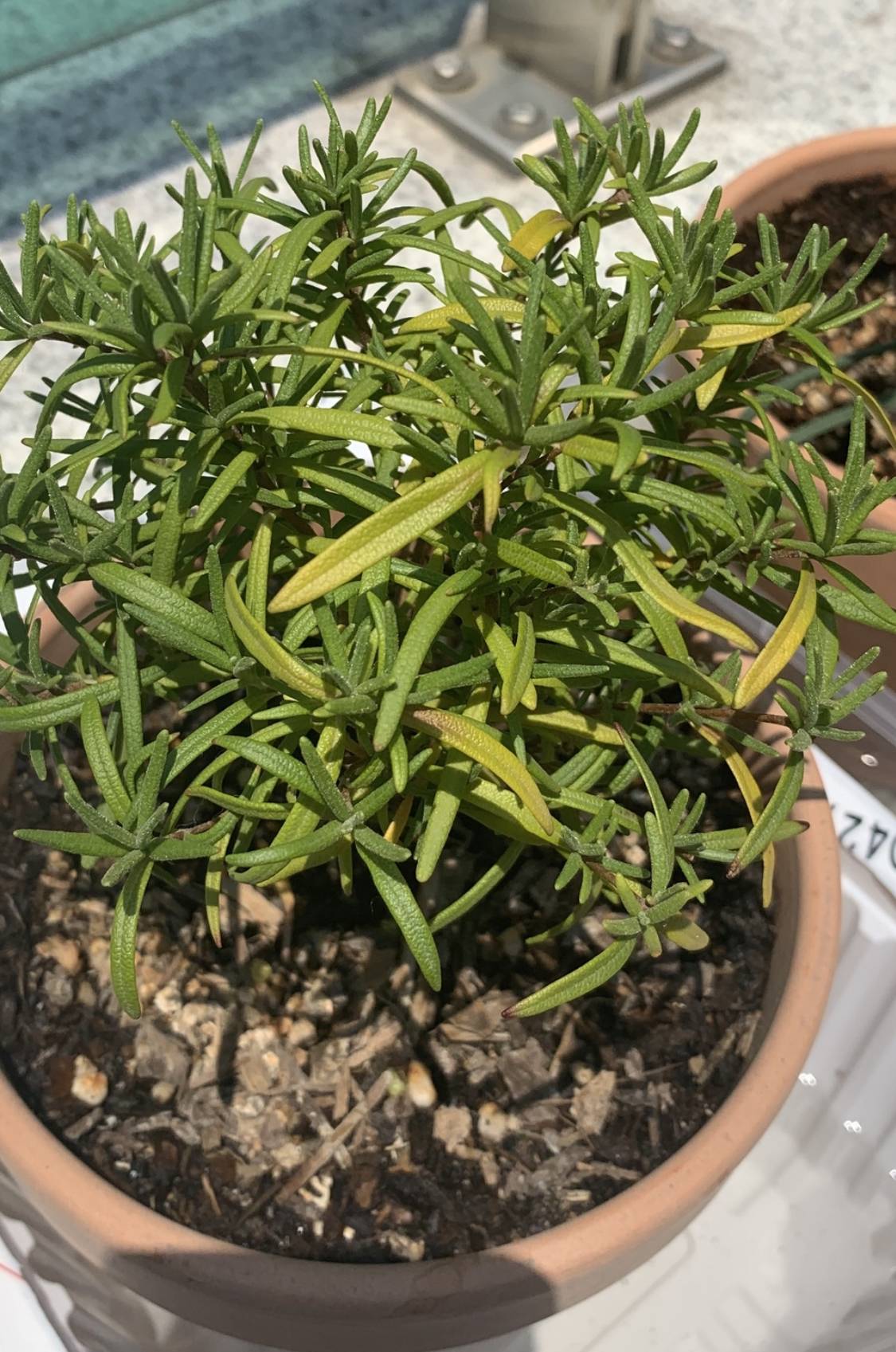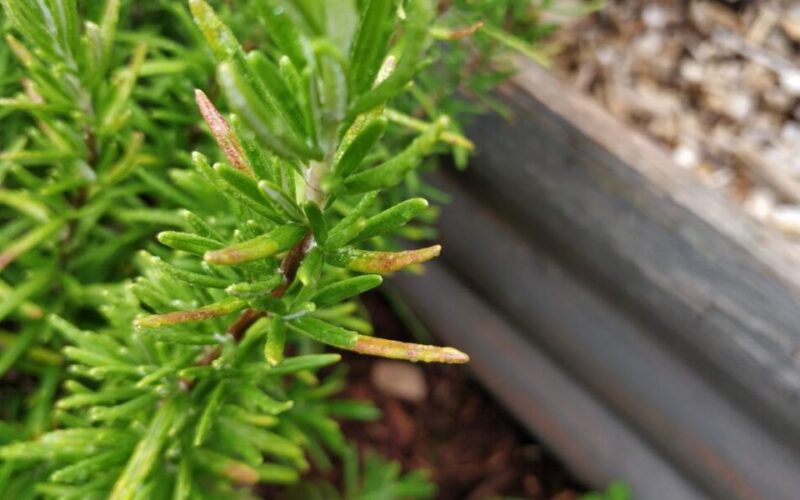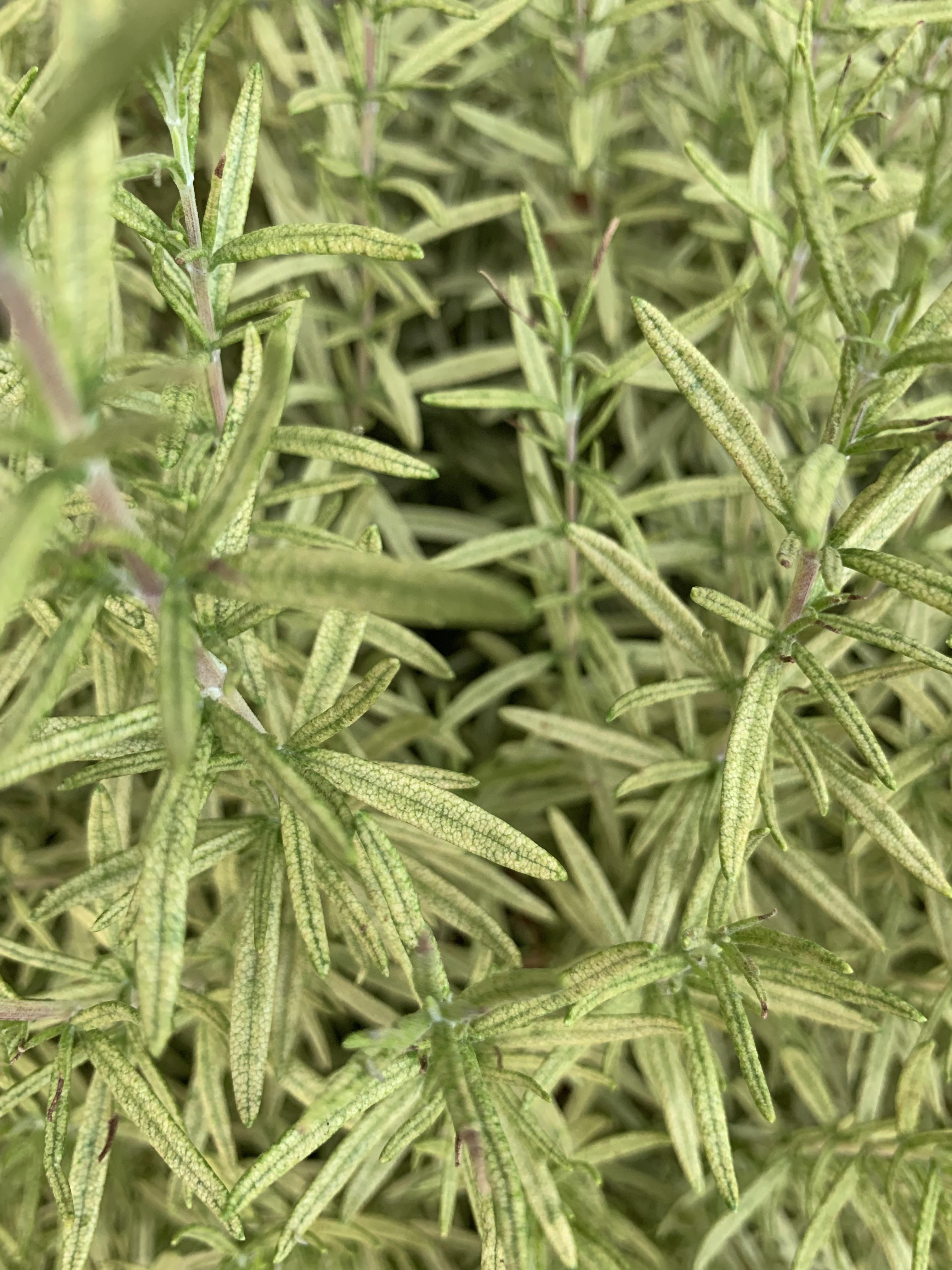
The reason rosemary leaves are turning yellow is because of too much nitrogen in the soil or as a sign of stress, due to damp soils as a result of overwatering or slow draining soils. Rosemary is a drought-resistant plant that flourishes in poor, well-draining soils and full sun.
If the pot is too small or the roots are attached to the pot, the leaves of rosemary plants in pots may also become yellow.
In contrast to plants that only tolerate acidic or neutral soil conditions, such as roses, rosemary grows in the Mediterranean region of Europe in soils that range from acidic to alkaline with an optimal pH of between 6 and 7.5. As a result, chlorosis caused by alkaline soils is not likely to be the reason why rosemary leaves are turning yellow.
Read on to find out the cause of your rosemary’s yellowing leaves and how to fix it.
Table of Contents
High Fertile Soil Causing Rosemary Leaves to Turn Yellow
Being planted in rich soil that may have been treated with manure (which is abundant in nitrogen) or using too much fertilizer are two common causes of rosemary leaves becoming yellow.
Native to the Mediterranean region of Europe, rosemary plants flourish in nutrient-deficient, sandy or stony soils.
The greatest fragrances and the most flavorful leaves for culinary use are produced by rosemary in this soil type, to which it has specifically adapted.
Therefore, rather than a nitrogen shortage, more issues that cause the leaves to turn yellow likely to occur.
The leaves of rosemary can turn yellow as a symptom of stress if the soil is too rich in nitrogen if you have used a high nitrogen fertilizer. Rosemary is a hardy plant that can survive in a variety of soil types as long as they are properly draining (loam, sandy, chalky soils).
Additional indications of nitrogen stress include:
- a diminished flavor and aroma from the foliage
- More foliage is growing, but there are fewer blooms.
According to studies, rosemary grown in soil that contained more sand, stone, or perlite and less fertilizer produced more oils in the leaves than rosemary grown in soil that contained richer soil and more fertilizer, which improves the flavor and perfume of the plant.
Replicating the natural growing conditions that rosemary is evolved to in your garden is the key to good growth.
This indicates that planting them in a sandy soil mixture that doesn’t contain as much water or nutrients would replicate their native soil type and allow for good drainage while generating the low to medium nutrient environment in which rosemary flourishes (20% sand or grit to 80% potting soil or compost).
Rosemary should get all the nutrients it needs without additional fertilizer if you have it in a large enough container (smaller pots have less soil capacity and therefore the roots have less access to minerals).
(Read my post on selecting the ideal pots for rosemary.)
The only fertilizer a rosemary plant needs is a well-balanced light fertilizer that is applied once a year in the spring, but even then, it is unlikely to be necessary in the same manner that it is for developing plants like roses or hostas, which are heavy feeders and demand regular feeding.
Over Watering, Humidity or Slow Draining Soils

Over Watering:
Overwatering is one of the most frequent reasons that rosemary plants turn yellow.
Rosemary is native to the Mediterranean region of Europe, where it thrives in full sun, well-draining soils that are frequently stony or sandy, and little to no rainfall.
The rosemary plant has thin, almost needle-like leaves that are shaped to minimize transpiration, or the loss of water via the leaves.
Because rosemary thrives in arid locations with dry soil, gardeners frequently overwater it, which causes the leaves to become yellow and indicate stress.
Between each watering, rosemary loves the soil surrounding its roots to become dry.
The leaves can become yellow or possibly brown if the soil or compost in a container is continually wet since they prefer dryer conditions.
Slow Draining Soils:
The rosemary leaves may become yellow despite occasional watering if the soil is sluggish or wet, which has the same effect as excessive watering.
Native to France, rosemary frequently thrives in sandy soil or on hillside slopes where the soil drains quickly and cannot effectively retain rainwater.
When rosemary is cultivated in:
- compacted soils or heavy clay
- excessively moist, sand-free, and rich-in-moisture compost
- Low-lying portions of the garden, as well as those that are close to a spring or stream, tend to be wetlands
- a more humid microclimate without any breeze in your garden (such as in a corner of a patio)
…then the rosemary may have water sensitivity, resulting in yellowing of the leaves.
Another issue is if your rosemary plant is in a pot or container without drainage holes in the bottom, which prevents excess water from evaporating and causes the soil to stay damp, increasing the risk of yellow leaves and root rot.
(Read my post on the ideal potting soil for rosemary.)
Humidity:
Another potential issue that could contribute to rosemary leaves becoming yellow from moisture stress is a humid atmosphere.
Rosemary grows naturally in Southern European coastal areas where there is a constant breeze that moves through the foliage. The rosemary leaves may turn yellow or brown as a sign of stress in still, possibly humid air.
Another risk factor for root rot and fungus disease is this. As rosemary enjoys open spaces with a light wind, it can suffer if the pot is placed in a patio corner or in a humid microclimate with other plants.
How to Resolve Yellow Rosemary due to Water Sensitivity
Rosemary that has been too wet and turned yellow has to be treated by:
- Reduce water usage to once every two weeks.
- If the soil drains slowly, add sand or grit to the area.
- The Rosemary should be moved to a pot with sufficient drainage.
- If the rosemary is in a pot, move it to a garden location that is open to allow for greater airflow.
Due to its Mediterranean ancestry, rosemary is drought tolerant after it has established itself in a particular area of your garden and only has to be watered once every two weeks with a deep soak.
Always give Rosemary a good soak when you water it, as this helps the roots develop properly and increases the plant’s resistance to drought.
If overwatering is the issue, let the Rosemary dry out for two weeks before watering it regularly once every two weeks from spring until late fall. If this works, the roots and leaves should be able to recover and turn a healthier green rather than yellow.
I advise amending the soil with horticultural sand or grit if the soil is difficult to drain. By doing this, the earth’s drainage will be improved, preventing the roots from sitting in permanently soggy soil.
I advise planting potted rosemary in a soil mixture that is around 20% sand or grit to 80% compost because this closely resembles the soil conditions of the Mediterranean region, where rosemary grows well.
If the rosemary is growing in heavy clay soil or a wet place, you should move it to a dryer location and add sand or grit to the soil to enhance drainage. You might also move the rosemary into a pot.
Here is a useful YouTube video that shows how to dig up a rosemary plant and transplant it while minimizing transplant shock:
Another excellent technique to increase airflow around the leaves is by using pots and containers. Compared to planting rosemary on garden soil, pots and containers typically have better drainage conditions and permit air to circulate more effectively around the rosemary.
(Read my post Why is my rosemary dying for additional information on the causes and remedies of a rosemary’s demise.)
Other Possible Causes:

Rosemary is a plant that thrives naturally in hot, sunny weather for the most of the year (in the South of Europe), with few cloudy days and moderate winters.
Your rosemary may grow sparsely and possibly leggily, with fewer flowers, if it is not in full sun. Insufficient plant health might also be indicated by yellowing leaves.
This can be easily fixed by either transferring the rosemary in a container to a site with direct sunlight or, if it was planted in garden soil, by relocating the rosemary to a location with greater sunlight.
The plant should start to recover in a few weeks with better growth, a stronger smell, and perhaps more flowers, in addition to the leaves changing from yellow to a more vibrant green.
Pot Bound Rosemary Plant
When it comes to cultivating healthy rosemary, pot size is crucial. The roots won’t have enough room to get the nutrients and water they need if the container is too tiny, which might cause the leaves to become yellow.
To guarantee that the pot has enough space for soil and that the rosemary can grow healthily without getting pot-bound and unwell, use a pot that is at least 12 to 16 inches across.
Even for rosemary, which likes darker soil conditions, a small container can cause the soil to dry up too soon in the full sun before the roots have a chance to absorb the water.
The soil also protects the roots from the cold by acting as insulation. Due to its poor cold tolerance, rosemary may need protection in the winter. Since the roots are particularly susceptible to cold temperatures, a little pot would not have enough soil to protect them from the cold.
Soil pH and Yellow Rosemary Leaves (Alkaline soils are not the cause)
Many plants that grow well in acidic soils, such as roses, azaleas, rhododendrons, etc., develop chlorosis, which is eventually brought on by the soil being excessively alkaline and making it difficult for the plant to absorb the nutrients it needs.
In these situations, the leaves turn yellow yet the leaf veins stay green.
With Rosemary, this is not the case at all!
Gardeners have been known to apply iron chelates and modify the soil to make it more acidic after assuming that the soil is too alkaline or deficient in iron.
Since rosemary can tolerate a pH range of 4.5 to 8.3, but the ideal range for growing healthy rosemary is pH 6 (mildly acidic) to pH 7.5, the leaves are unlikely to turn yellow due to chlorosis. Rosemary grows naturally in calcareous soils in the Mediterranean countries and is suited to growing in both alkaline soils and mildly acidic soils (slightly alkaline).
Since the majority of organic matter has a pH of 6-7 after it has fully decomposed, most garden soil is in this range. Therefore, soil pH is very unlikely to be the cause of your rosemary plants’ yellowing leaves unless the soil is excessively acidic or alkaline, in which case very few healthy plants would be able to grow in your garden. It is much more likely that the leaves are yellow due to water stress or an excess of nitrogen.
Key Takeaways:
- Due to high nitrogen soils, water sensitivity, being confined to a pot, or even a lack of sunlight, rosemary leaves can become yellow.
- Since rosemary can thrive in alkaline soil, chlorosis is not likely to be the root of the plant’s yellowing leaves.
- The yellow leaves should recover and become green if you mimic the Mediterranean conditions that rosemary prefers, which include full sun, well-draining soil, rarely watering, and low to medium nutrition soil.
FAQ
Why does my rosemary look like its dying?
Root rot, which is brought on by excessive watering and poorly draining soils, causes rosemary to become brown and die back. Rosemary is a drought-resistant plant that needs sandy soil that drains well. The main cause of rosemary plants dying and becoming brown is too much moisture around the roots.
Should I remove brown leaves from rosemary?
With a pair of pruners, remove any brown leaves from plants that have experienced frost damage. This encourages new development, and the plant should recover. But if any additional cold spells are anticipated, I advise you to cover the rosemary plant.
How do you salvage rosemary dying?
It is advisable to transplant your dead rosemary plants to a sunny, well-drained area if you want to save them. Alternately, put them in a good pot with sufficient soil drainage holes. Let them dry between waterings and water them less frequently, once a week.
How do you green up rosemary?
For optimum results, always put your rosemary in full light; otherwise, it won’t grow and won’t survive very long. If the rosemary is in the growing season, move it into full sun or, more conveniently, place the pot it is in in the sun. The rosemary should come back to life and begin to grow again.
